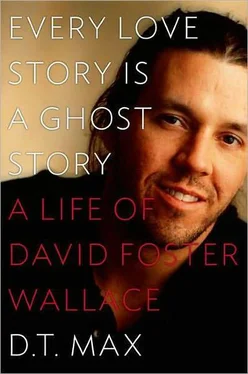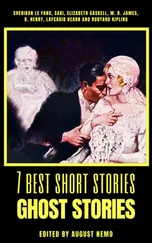Wallace saw an opportunity. He told Green that he wanted to make a change. “You know what? I’m up for it,” she remembers answering, figuring he could not be stopped anyway. She knew the decision came out of an area of deep conflict for him. “The person who would go off the medications that were possibly keeping him alive was not the person he liked,” she says. “He didn’t want to care about the writing as much as he did.” Soon afterward, he stopped the drug and waited for it to flush out of his body. For the first weeks, he felt that the process was going well. “I feel a bit ‘peculiar,’ which is the only way to describe it,” he emailed Franzen in August, who had checked in to see how he was doing. “All this is to be expected (22 years and all), and I am not unduly alarmed. Phase 4 of withdrawal/titration commences today. It’s all OK. I appreciate the monitoring.” The next month brought “disabling nausea/fatigue” and left him more concerned: “I’ve been blowing stuff off and then having it slip my mind,” he wrote his friend. “This is the harshest phase of the ‘washout process’ so far; it’s a bit like I imagine a course of chemo would be.” He remained “fairly confident it will pass in time.” GQ took his picture for their October 2007 issue, and in it, he looked skinny and unshaven, a grizzled version of his Amherst self. Wallace had never entirely put out of his mind the fundamentalist faction in recovery that regarded prescription drugs as a crutch. The plan was for him to go from Nardil to another antidepressant, but he now decided he should try to be completely drug free. Green was worried. Her husband, she remembers thinking, was expecting “a Jungian rebirth.” Soon afterward, Wallace had to be hospitalized for severe depression. When he got out, doctors prescribed new drugs. But he was now too panicked to give them time to work. He took over the job of keeping himself sane, second-guessing doctors and their prescriptions. If he tried an antidepressant, he would read that a possible side effect was anxiety, and that alone would make him too anxious to stay on the drug. He wrote to Nadell in December, “Upside: I’ve lost 30 pounds. Downside: I haven’t even thought about work since like September. I’m figuring I get 90 more days before I even remotely expect anything of myself — the shrink/expert says that’s a fairly sane attitude.” When his sister, Amy, would call, he would tell her, “I’m not all right. I’m trying to be, but I’m not all right.”
He continued to write in a notebook, but he did not have the strength to return to his challenging manuscript. “The Pale King” had once referred to the IRS, and possibly to the state of contentment and focus the book advocated; but now it was a synonym for the depression that tormented him, or death. Not all days were bad. He taught throughout. He emailed friends. He and Green tried to maintain their lives. Always self-critical, Wallace would rate good days as “B-plus” or “cautiously optimistic.” They joked about the unthinkable. Green warned him that if he killed himself she’d be “the Yoko Ono of the literary world, the woman with all the hair who domesticated you and look what happened.” They made a pact that he would never make her guess how he was doing.
During the spring of 2008, a new combination of antidepressants seemed to stabilize Wallace. It looked like the worst might be over. In February, he had written to Tom Bissell, a writer who was a new friend, “I got really sick over the fall. Pneumonioid-type sick. Lost a scary amount of weight. I’m still not all the way back on my feet. I’m twelve years older than you; I feel more like 30 years older right now. This return letter will probably be the most ‘work’-type thing I do today, writing-wise.” He added that he had been reading Camus lately: “He’s very clear, as a thinker, and tough — completely intolerant of bullshit. It makes my soul feel clean to read him.” He taught a class in creative nonfiction that semester. Students who had studied with him before, though, noticed that his comments were terser, his playfulness muted. On the last day of class, he choked up. The students were confused; where was the Wallace they knew? At a coffee shop afterward he cried again. “Go ahead and laugh,” he told them, but they knew something was wrong.
That spring GQ asked him to write an essay on Obama and rhetoric and he felt almost well enough to do it. Obama gave him hope; he and Green even talked about his being a speechwriter for the candidate. The magazine reserved a hotel room for him in Denver for the Democratic convention and began to make arrangements, but soon he canceled. When the New York Times Magazine approached him to write about the Olympics in Beijing that summer, he apologized but said he wasn’t feeling well enough. Nadell was busy explaining that her client had a stomach malady. “It had to be severe enough to explain why he couldn’t travel,” she remembers. Wallace would mine House for diseases he could suggest to others he might be suffering from.
Wallace’s parents were slated to come visit. His relationship with them was the best it had been in years; he told Green he had no idea what had made him so mad at his family in his thirties. “We’ll have big fun,” he promised them. But then he asked them to wait. That June, the annual booksellers’ convention was in Los Angeles, and Green and Wallace drove the thirty miles of roadway to have dinner with Pietsch, Nadell, the humor writer David Sedaris, and his publicist Marlena Bittner, who also worked on Wallace’s books. Sedaris was surprised at how funny and gentle Wallace was, how full of praise for his students. At the end Pietsch asked Wallace how he was doing. “You don’t wanna know,” his writer replied. When they hugged, Pietsch looked into Wallace’s eyes and thought they looked “haunted.”
About ten days after the dinner, Wallace checked in to a motel about ten miles from his home and took all the pills he could find. When he woke up, he called Green, who had been searching for him all night. She met him at the hospital and he told her that he was glad to be alive. He was sorry that he’d made her look for him. She had him transferred to the university’s hospital, his speech still slurred for a week. The suicide note he’d mailed got to her several days later. She painted their garage door red to match the inside, a promise she’d made him in the hospital. He switched doctors and agreed to try electroconvulsive therapy. He was terrified at the prospect — he remembered how ECT had damaged his short-term memory in 1988—but he underwent twelve sessions.
Franzen came for a visit while the treatments were in progress in July. He now spent part of each summer in nearby Santa Cruz writing. He was astonished at the changes in his friend’s body and mind. They would play with the dogs or go outside so Wallace could smoke. Franzen asked what he had been thinking when he tried to kill himself and Wallace winced and said he didn’t remember. He was barely able to read, not even the thrillers he ordinarily devoured. Instead he mostly watched TV. After dinner, Werner licked out his mouth.
Wallace’s illness was taking a huge toll on Green; she was exhausted. For one nine-day period, she didn’t leave their house. When she did go out, Wallace’s friends from his Claremont recovery group kept him company. Later in the summer a yard hose went missing and Green found it in the trunk of their car. He had planned to tie it to the exhaust pipe using his bandana. When she confronted him, he insisted he had already decided not to go through with it. She did not believe him and had him hospitalized again.
In August, Stirling suffered an athletic injury, and Green wanted to be with him, so Wallace’s parents stayed with Wallace for ten days. He was close to giving up hope. “It’s like they’re throwing darts at a dartboard,” he complained to them about his psychiatrists. They went with him to an appointment; when the doctor suggested a new drug combination, Wallace rolled his eyes. He was a shut-in now, worried he’d run into his students if he went into town. Sally Wallace cooked him the meals he had loved as a child — casseroles and pot pies; they watched The Wire . It was obvious to his family that he was in unendurable pain. Before she left, he thanked her for being his mother.
Читать дальше












